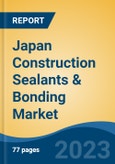Speak directly to the analyst to clarify any post sales queries you may have.
10% Free customizationThis report comes with 10% free customization, enabling you to add data that meets your specific business needs.
Japan Construction Sealants & Bonding Market is anticipated to increase at an impressive rate in the forecast period. Building Envelope (façade waterproofing, façade air barriers, window & door installation, roof waterproofing), bonding (flooring covering, floor preparation & maintenance, interior sealing, joint sealing) including glazing, flooring, and joining, as well as in sanitary and culinary areas, and a variety of other applications use construction sealants and bonding. These expanding applications have fueled the market's growth for construction sealants and bonding. The growing usage of bonds in more recent building applications such as ductwork, anchoring, and structural glazing is driving the market for construction sealants. Construction sealants are used in the window frame, sanitary and kitchen systems, expansion joints, floor systems, walls, and panels. In the face of shifting atmospheric conditions, they can withstand tension and prevent fracture.
Increasing Demand from Construction Industry
In Japan, demand for permanent and non-slum housing is increasing due to urbanization, population growth, and increased affluence. The enormous rise in residential development in these countries drives the construction sealants business. Due to the numerous applications of sealants in building and construction, including waterproofing, weather-sealing, crack-sealing, and joint-sealing, the construction industry currently maintains the majority share of the Japanese sealants market, followed by other end-user industries. Construction sealants are also made to be long-lasting and simple to apply on many substrates. In 2020, the Japanese construction industry contributed 5.9% of the country's GDP, and in the years to come, it is expected to rise further. The Japanese government prioritizes building quality and supports sustainable growth, which would probably increase demand for sealants throughout the projection period.
Growing Technological Advancement for Sustainable Development
The development of bio-based sealants is being pushed forcibly by manufacturers, and this is anticipated to open new avenues for expanding the sealant market globally. For the projected period, the global construction sealants and bonding market is expected to have profitable growth prospects due to the demand for low-volatile organic compounds and green, sustainable sealants. However, the adverse environmental effects of sealants limit market expansion. Due to their chemical makeup and the chemicals used to make them water-repellent, products like sealants, varnishes, and paints produce volatile organic compounds. These substances interact with the atmosphere through a photochemical process. The carbon compounds are bad for the environment and cause instability and changes to the atmosphere.
Recent development
In November 2021, Sika AG acquired Hamatite, the adhesives division of The Yokohama Rubber Co., Ltd. According to reports, Hamatite dominates the Japanese industry and supplies adhesives and sealants to the building and automobile industries. The company, which has its headquarters in Tokyo, has yearly sales of USD 176 million.
Market Segmentation
Japan Construction Sealants & Bonding Market is segmented based on technology, resin type, component, application, and end use
Based on technology, the market is divided into reactive, hot melt, solvent based, water based and others. Based on resin type, the market is divided into polyurethane resin, modified silicone, polysulfide, butyl rubber, acrylic, acrylic urethane & others. Based on component, the market is divided into component, two components, and others. Based on End Use Industry, the market is divided into residential, commercial, civil engineering & others.
Market Players
Konishi Co., Ltd, Cemedine Co., Ltd., Sunstar Engineering Solutions (SE), The Yokohama Rubber Co Ltd, Shin-Etsu Chemical Co., Ltd, and Dow Toray Co., Ltd are the key players operating in the Japan Construction Sealants & Bonding.
Report Scope:
In this report, Japan Construction Sealants & Bonding has been segmented into following categories, in addition to the industry trends which have also been detailed below:
Japan Construction Sealants & Bonding, By Technology:
- Reactive
- Hot Melt
- Solvent based
- Water based
- Others
Japan Construction Sealants & Bonding, By Resin Type:
- Polyurethane Resin
- Modified Silicone
- Polysulfide
- Butyl Rubber
- Acrylic
- Acrylic Urethane
- Others
Japan Construction Sealants & Bonding, By Component:
- One Component
- Two Component
- Others
Japan Construction Sealants & Bonding, By End Use:
- Residential
- Commercial
- Civil Engineering
- Others
Japan Construction Sealants & Bonding, by region
- Hokkaido & Tohoku
- Kanto
- Chubu
- Kansai
- Chugoku
- Shikoku
- Kyushu
Competitive Landscape
Company Profiles: Detailed analysis of the major companies present in Japan Construction Sealants & Bonding.
This product will be delivered within 1-3 business days.
Table of Contents
Companies Mentioned (Partial List)
A selection of companies mentioned in this report includes, but is not limited to:
- Konishi Co., Ltd
- Cemedine Co., Ltd.
- Sunstar Engineering Solutions (SE)
- The Yokohama Rubber Co Ltd
- Shin-Etsu Chemical Co., Ltd
- Dow Toray Co., Ltd








